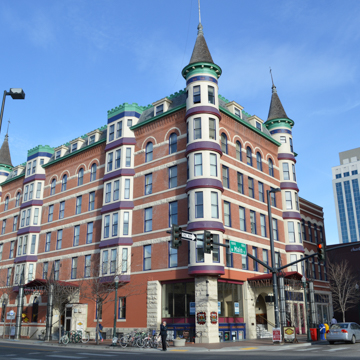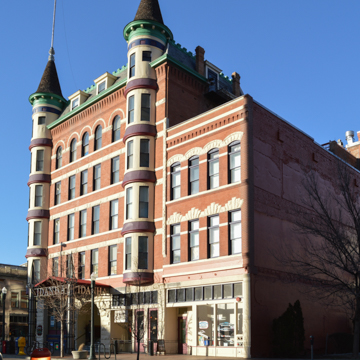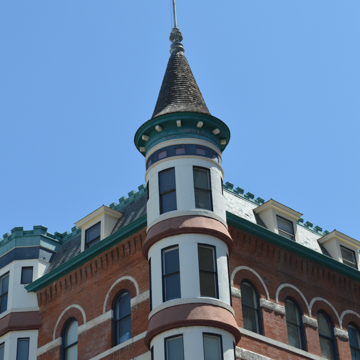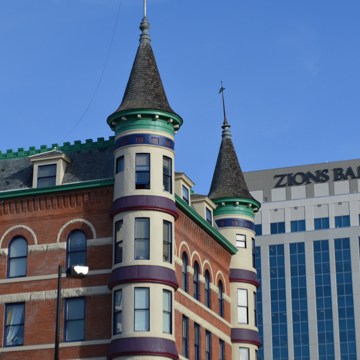You are here
Idanha Apartments
Once considered the finest hotel in Idaho, the Idanha is a local landmark and a signature example of adaptive reuse to provide affordable housing in downtown Boise. At the Idanha’s grand opening on January 1, 1901, guests were welcomed to a first-class hotel with amenities the Idaho Statesman declared to be the “acme of perfection.” The Idanha’s glory years lasted until demand for traditional downtown hotels began to diminish in the 1950s, in tandem with changing cultural preferences. The Idanha’s origins and its recent renewal parallel the growth and transformation of downtown Boise over the course of the twentieth century.
With the introduction of passenger train service to downtown Boise in 1894 the need emerged for a hotel in proximity to the depot. Architect Walter Stewart Campbell, who practiced in Boise in 1891–1904, actively promoted the idea of a luxury hotel to investors. Campbell had toured state-of-the-art hotels in major North American cities, and these examples likely influenced Campbell’s decision to design the Idanha Hotel in the Chateauesque style, its first commercial application in the city. In particular, the work of fashionable New York architect Bruce Price provided compelling precedents in Quebec’s Hotel Frontenac and Montreal’s Place Viger. In Boise, Campbell took advantage of the site’s prominent location at the major intersection of Tenth and Main Streets to create an eye-catching design using round turrets to delineate each of the hotel’s three highly visible corners.
In its massing and details, the Idanha contrasts with its surroundings. Most buildings constructed in downtown Boise during the late nineteenth century were two to three stories with boxy proportions. At six stories, the vertically proportioned Idanha was the tallest building in Boise and the first with an elevator. Buildings of the period were typically constructed in neutral shades of Boise sandstone. The Idanha, in contrast, has exterior materials in vibrant colors, notably the red brick fascia over its steel frame. Key features are highlighted in painted, rusticated stone including arched entryways, storefront pilasters, and continuous horizontal bands that serve as lintels over windows at each floor.
During its heyday, the 140-room hotel boasted an equally impressive interior. The grand lobby featured golden oak millwork, Italian marble, terrazzo flooring, and the hotel rooms had plentiful daylight. Amenities also included card and billiard rooms, a barber shop, and a curiosity window for guests to view the mechanical systems of the Otis elevator. The Idanha’s picturesque form, with its dormered mansard roof, vertical window bays, and corner towers, afforded a range of accommodations from luxurious suites to attic rooms. During the early twentieth century, the hotel welcomed such distinguished guests as Presidents Theodore Roosevelt, William Taft, and Benjamin Harrison, actor Will Rogers, and songwriter Roger Miller. The hotel gained national exposure in 1907 through its association with Idaho’s “trial of the century,” in which labor union leader Harry Orchard was accused (and later acquitted) of assassinating former Idaho governor, Frank Steunenberg. The Idanha was the target of a failed plot to blow up the hotel with the governor inside.
The Idanha’s gradual decline following World War II echoed national trends. The hotel’s location in close proximity to the railroad station was less attractive to automobile driving patrons who preferred accommodations with on-site parking. The hotel’s infrastructure was in need of modernization, especially its HVAC systems. Finally, the outmigration to surrounding suburbs of Boise’s population and retail sectors siphoned downtown’s urban and economic vitality and diminished the district’s appeal as a destination for visitors and business travelers. Between 1965 and 1974, the plight of the hotel and the surrounding area was further aggravated by Boise’s aggressive pursuit of federal urban renewal funds intended to redevelop the declining central city. The Boise Renewal Agency’s (B.R.A) ill-conceived plan for clearing twelve downtown blocks of historic buildings was meant to entice developers to erect a new, mega-shopping mall along with modern hotels. The plan placed the historic Idanha in a precarious position with an uncertain future, which exacerbated an already deferred program of maintenance and repair. Ultimately, only a portion of the B.R.A’s demolition plan was executed and failure to attract downtown investment, along with public pushback, ultimately caused the B.R.A. to issue a redefined renewal plan in 1987. With input from the American Institute of Architects, Zimmer Gunsul Frasca (ZGF), a local firm, devised new priorities focused on establishing a pedestrian-oriented urban core, preserving historic buildings, and re-purposing them whenever feasible.
In 1999 the Idanha ceased operation as a hotel and the following year was rehabilitated as affordable housing by developer Kenneth Howell of Parklane Management Company. Howell leveraged federal historic and low income housing tax credits to raise funds for the hotel’s exterior preservation and the adaptation of its interior. The rehabilitated structure included seismic upgrades, conversion of hotel rooms to fifty-three apartments, and upgrades to the hotel’s common and retail spaces for contemporary commercial use. Today, the Idanha provides important affordable housing options for its primarily young residents who work in the downtown service industry. Thanks to a change in attitude concerning historic resources and to Howell’s vision, the Idanha continues to command the intersection of Tenth and Main Street in downtown Boise.
References
Bauer, Barbara Perry, and Elizabeth Jacox. “Idanha Hotel.” In Shaping Boise: A Selection of Boise Landmark Buildings,edited by E. Jensen and J. Austin, 20-21. Boise, ID: City of Boise, Department of Planning and Development Services, 2010.
Ken Howell, President, Parklane Management Company LLC. Interview by Wendy R. McClure. Boise, ID, March 4, 2015.
Meredith, Neil J. Saints and Oddfellows: A Bicentennial Sampler of Idaho Architecture. Boise, ID: Boise Gallery of Art Association, 1976.
Renk, Thomas, “Idanha Hotel,” Ada County, Idaho. National Register of Historic Places Registration Form, 1974. National Park Service, U.S. Department of the Interior, Washington, DC. https://history.idaho.gov/wp-content/uploads/2018/09/Idanha_Hotel_74000728.pdf.
Webb, Anna. 150 Boise Icons: To Celebrate the City’s Sesquicentennial.Boise, ID: Idaho Statesman, 2013.
Writing Credits
If SAH Archipedia has been useful to you, please consider supporting it.
SAH Archipedia tells the story of the United States through its buildings, landscapes, and cities. This freely available resource empowers the public with authoritative knowledge that deepens their understanding and appreciation of the built environment. But the Society of Architectural Historians, which created SAH Archipedia with University of Virginia Press, needs your support to maintain the high-caliber research, writing, photography, cartography, editing, design, and programming that make SAH Archipedia a trusted online resource available to all who value the history of place, heritage tourism, and learning.





















